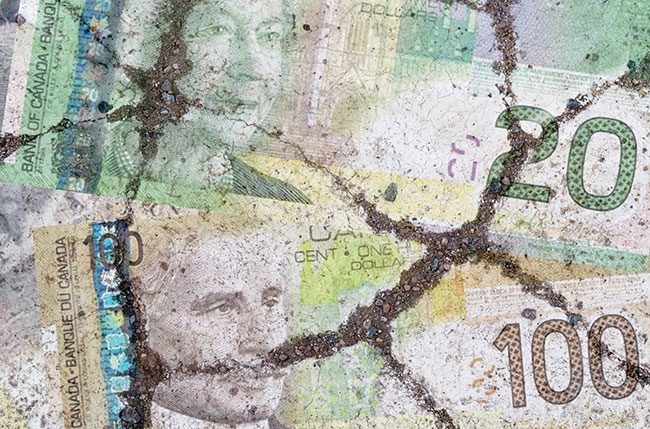
Features
Business
Finance
Outlook for LPs cloudy amid shifting conditions
Questioning the financial sustainability of Canada’s overregulated market
June 12, 2023 By Jake Hribljan
 Photo: Dzmitry / Adobe stock
Photo: Dzmitry / Adobe stock As Canada’s economy barrels closer to recession territory, cannabis industry players continue bracing for layoffs and restructuring amidst a sector already navigating high excise duties and increasing debt obligations.
Canada’s third largest LP Canopy Growth announced in February that they would be laying off roughly 60 per cent of their workforce as they work towards profitability, 40 per cent of which took place immediately with the layoff of 800 employees and the closure of their Smiths Falls Ont., 1 Hershey Dr. facility. Aleafia Health also laid off 36 per cent of their full-time equivalent workforce in 2022, and Canada’s second largest producer by market cap, SNDL, made additional February layoff announcements.
The effects of mounting debt have reverberated across the industry, and now rising interest rates will be another factor of concern.
After legalization in 2018, many LPs took on massive debts to fund growth and capture market share. A report by the Canadian Imperial Bank of Commerce found that Canadian cannabis companies had accumulated more than $3 billion in debt by the end of 2019. These debts were also attributed to significant upfront costs to meet the standards of new regulations. In 2021, Aurora Cannabis, Canopy Growth, and Tilray all announced new debt offerings. 2023 was predicted by some in the cannabis industry to be a big year for mergers and acquisitions, as companies consolidated in a tighter lending environment.
Last year MNA volume was down 80 per cent, representing only USD$4.87 billion. However, if smaller companies fail to keep up with their debt payments required to fund their operations, or are forced to sell off assets, it could foreseeably rise.
Consolidation creates the opportunity for larger, more resilient companies that have more resources to weather the uncertain conditions.
Now, as banking sector concerns and rising interest rates impact the emerging American cannabis market, Canadian producers are also finding themselves looking for solutions.
Canopy Growth has been navigating the balance between managing debt loads and increasing market share for years, and on April 14, announced they reached an agreement to refinance $100 million in unsecured notes due in 2023. After finishing 2022 with a debt of $1.21 billion, Canopy’s interest expense jumped by 1128 per cent to $103.94 million, up from $8.46m the year prior.
Meanwhile, industry leaders find themselves struggling under the weight of excise duty tax. In fiscal year 2020-2021, the federal government collected just over $514 million in total cannabis duties.
“Because of price compression, excise tax has become a larger percentage of each sale and is exasperating the cost of excise tax,” said Tilray Brands CEO, Irwin Simon, in his company’s most recent earnings call. “Tilray has paid approximately $120 million in excise tax and corporate income tax in the last 12 months [to] the Canadian government…No question that [the] Canadian government has been the most profitable cannabis business in our industry.”
C3 noted in a statement: “In the 2021/22 fiscal year, governments earned $1.6 billion dollars in revenues from legal cannabis sales. With legal retail sales totaling $4 billion per year, 40 per cent of all revenues from the sale of legal cannabis are going to governments.” Meanwhile, excise duty tax debt owed by LPs is at an all-time high, sitting at $97.5 million halfway through the 2022-23 fiscal year, according to CRA data.
This comes as an unregulated and untaxed illicit cannabis market represents roughly 40 per cent of the total Canadian cannabis industry.
“There are two very different cannabis markets in Canada: one that’s legal, highly taxed, and regulated; and one that’s thriving and illicit. The unregulated illicit market is generating billions of dollars of revenue, with a 40 per cent market share and faces virtually no risk of enforcement,” David Klein, CEO of Canopy Growth, told investors during Canopy’s Q3 2023 call.
“The competition with the illicit market, compounded by an overbuilt legal cannabis industry, has caused price compression across the board. We expect the sector challenges to remain for years to come,” he continues. “And as a result, the sustainability of this legal sector is in question.”
These growing concerns are repeatedly being brought to politicians and regulators and are slowly gaining attention. The OCS announced it would be reducing its markup rates in a bid to help the financial viability of the legal market and combat the illicit.
“We appreciate and applaud the OCS’ commitment to transparent mark-ups and the reduction in its mark-up rates,” said George Smitherman, CEO of C3.
Despite these challenges, the Canadian cannabis industry is still growing. According to a Deloitte Canada report, legalized recreational cannabis has added $43.5 billion to Canada’s GDP. The industry has created almost 100,000 new jobs and continues to beat yearly revenue estimates.
Still, there is continued investment interest from alcohol and tobacco companies, and the expansion of an international cannabis marketplace. As the Bank of Canada weighs further interest rate increases to combat inflation, which inevitably impacts the ability of LPs to service interest on debt and raise further capital, industry players will be forced to consider consolidations and cost reduction methods until the financial landscape becomes more clear.
Jake Hribljan is a Canadian freelance writer with a background in economics currently residing in the E.U. Twitter: @JakeHCE
Print this page